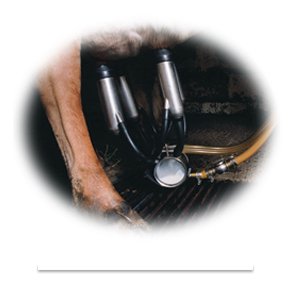Understanding My Results
Milk
Fat
The fat content of cow’s milk averages about 3.7% but varies
from less than 3 to over 6 percent, depending on breed, stage
of lactation, and a number of environmental conditions.
Protein
Fluid milk has about 3.5% protein. Amount vary according
to breed, stage of lactation, and certain environmental situations.
Somatic Cell Count (SCC)
The somatic cell count (SCC) is commonly used as a measure
of milk quality. Somatic cells are simply animal body cells
present at low levels in normal milk. High levels of these cells
in milk indicate abnormal, reduced-quality milk that is caused
by a intra mammary bacterial infection (mastitis). The cell
count for "normal" milk is nearly always less than 200,000 cells/ml.
Higher counts are considered abnormal and indicate probable
infection.
Lactose
Milk sugar. Lactose content of milk averages about 5%.
Other Solids
Lactose plus Ash (The residue remaining after complete combustion
at -500 to -600 C of a feed or feed product during proximate
analysis.)
Milk Urea Nitrogen (MUN)
Normal values are considered to be between 12 to 16 mg/dl.
High MUN levels can be due to an excess of dietary and/or soluble
protein, stress (including disease, exercise from grazing or
extreme cold), or too little rumen available energy in the diet.
Low MUN may be a result of an insufficient level of protein,
too little degradable protein, or insufficient energy in the
diet. As the non-fiber carbohydrate (NFC), crude protein ratio
increases, MUN decreases. MUN also decreases as lactation progresses.
Johnes, MAP (Mycobacterium Avium Paratuberculosis)
Johnes is the chronic infection of the small intestine
by the Mycobacterium Avium Paratuberculosi. This chronic infection
can result in poor absorption of nutrient material, thus resulting
in diarrhea and eventually emaciation of the cow. Death can
occur in some instances.
All results for Johne's testing will come directly from the
laboratory until further updates are made to reporting systems.
Results can also be sent to your veterinarian for further applications.
Johne's is a reportable disease , so all results must be reported
to the Board of Animal Health and the University of Minnesota
for statistical and research purposes only. There will
be no public record of results and no follow up on herds based
on milk ELISA or serum results.
Bovine Pregnancy ELISA
The Bovine Pregnancy ELISA is designed to detect a subset of
pregnancy-associated proteins (PAGs) in milk samples from
cattle. Secretion of PAGs from the placenta begins at the
time of implantation and circulatory concentrations
generally increase throughout pregnancy, peaking just before
parturition. Prompt detection of non-pregnant cows is
critical to reducing days open and interval between
services. The PAGs detected by the Bovine Pregnancy ELISA
have a shorter half-life than other commercially available
tests, allowing accurate determination of reproductive
status. In milk samples, the assay can be used as early as
35 days post-breeding and 60 days-in-milk.
The Bovine Pregnancy ELISA quantifies the level of PAGs in
milk. Results are presented in absorbance units (ELISA
Score), which is directly correlated with the amount of PAG
present in the sample.
In the current test, a sample with a value less than 0.10
units is considered ‘OPEN’, while a score of 0.25 or greater
suggests the presence of a developing placenta, which is
consistent with an active pregnancy. Therefore animals with
a score of 0.25 units or greater are identified as
‘PREGNANT’. Samples with ELISA scores between 0.1 and 0.25
are interpreted as ‘RECHECK’, indicating either not enough
PAG to confirm “PREGNANT” or too much PAG to confidently
call the cow “OPEN”. These cows should be confirmed at a
later date, either on the next vet check day or next DHI
test day. Recheck results should comprise less than 4% of
samples tested.
Milk: Sensitivity = 98.8%; Specificity = 97.7% A Sensitivity
of 98.8% means there is a 1.2% chance of a false Negative. A
Specificity of 97.7% means there is a 2.3% chance of a false
Positive.
DHIA Laboratories
825 12th Street South, PO Box 227
Sauk Centre, MN 56378-0227
320.352.2028
Email
Hours
Monday-Friday: 8AM-4PM
Drop Off Location
Sauk Centre Front Entrance Drop Off
Open 24 Hours





